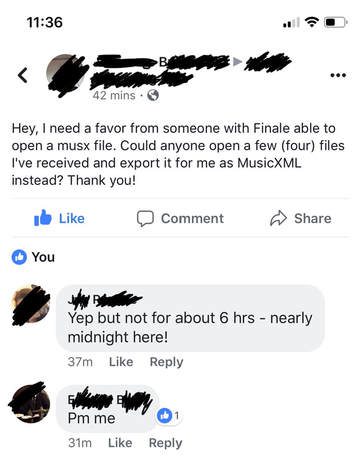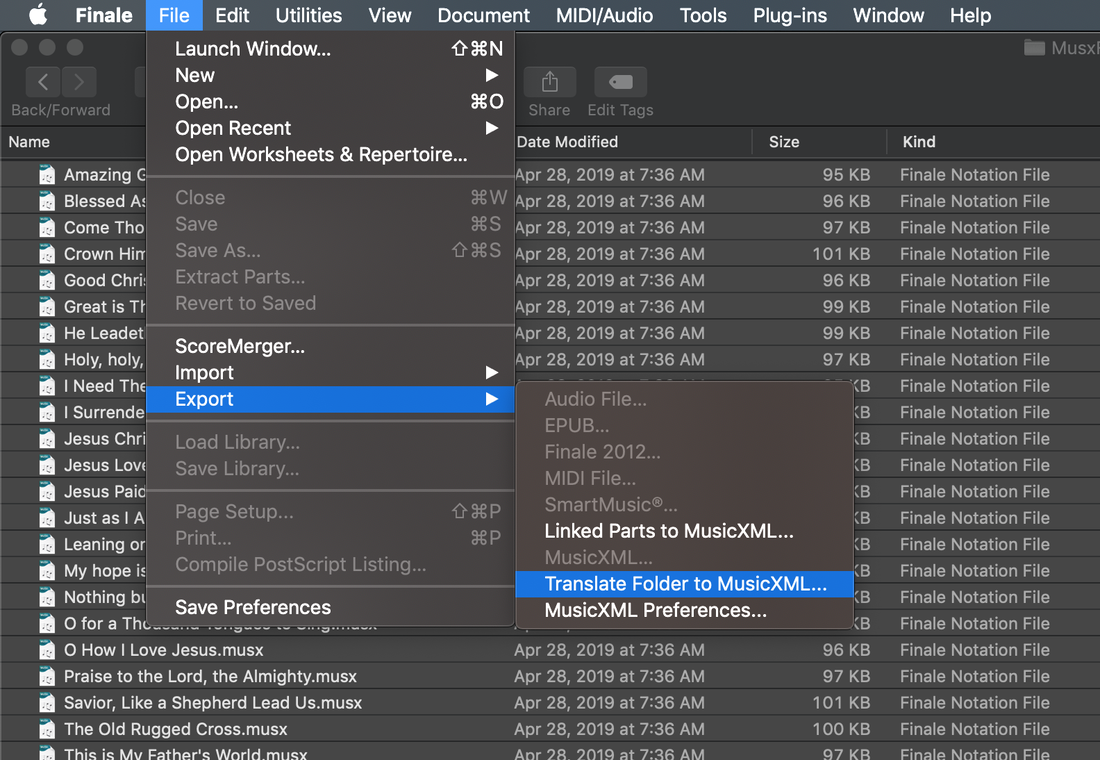What's Behind Door Number 3?It's time to face up to the truth, lyrics-only slides will never communicate rhythm & pitch, and Traditional Music Notation is a terrible user experience. It's time to give worship leaders (and their congregations) a third option.
My music notation is not just a tweak or a re-packaging of old notations; it's a fundamental re-design of how rhythm, pitch & lyrics are visually communicated to the user. In the mean time... I'm just selling MusicXML files in my own online store. But only songs that are 1) public domain, which makes them 2) so old that everybody already knows them; so the notation isn't that useful. Thus, we need new music sold in MusicXML, too.
So contact me, and let's chat about how this fulfills your company's purpose. |
Sell an industry-standard formatI explain it in more detail here, but suffice it to say that .pdf's aren't musical notation "data", they're just human-readable pictures of music notation. And third party apps, like mine, will never be able to read proprietary formats, like .musx.
So my users need you to sell your content in a format the industry has centralized around as its lingua franca, MusicXML. All music notation apps export to MusicXML. That's how composers are using my app without y'all adding another file format to your web store. Finale v25 and later even has a menu option to convert every Finale file in a given folder into MusicXML. So there is a clear path forward to convert your content catalogs to MusicXML. And, MusicXML is an open standard, that supports almost all the features of SingAccord, so selling it doesn't just support my app, but many others. |
UPGRADE YOUR CUSTOMERSWith my new notation, the demand for licenses for Lead Sheets in MusicXML will increase, to accommodate the entire congregation. Currently, most Christian music worship publishers have a sharp price difference between Churches which use lyrics-only, and providing music notation for lead sheets. These lead-sheet capable licenses usually come with full band orchestrations, which these little guys aren't going to start using. So you're probably going to want to meet them half way, and introduce a price tier where they get musically-notated Lead Sheets in MusicXML, but don't have to pay for full orchestrations. I know, I know, you're wondering about SATB files. Well, I intend to support them one day, but not yet. If you sell your catalog in MusicXML, I'll feature you on my website as a source for content.
|
A PI in the SkyWhat I'd like the most, is for my users to be able to log in to their account with you in my app, and search directly for content without having to bother going to the web browser & downloading files. But I know that even with modern SSO, that requires a degree of trust in me and coordinating my app releases with your API changes, which would be a significant collaboration. So for now, sell the MusicXML files on your website so that it doesn't matter if I'm trust-worthy or not, and it doesn't matter if my idea is successful or not.
Some publishers are asking if it would be better to just sell my custom file format. I'd prefer y'all sell MusicXML, but if pre-importing the songs and selling them in my file format is what it takes to get this show on the road, let's do it. |
a little help from my friends
|
No joke, if you just sell them .musx files, they might even have to head over to Facebook and ask if someone can convert the files for them. This image is an actual screenshot from an actual Facebook group I'm in, where an actual person actually had to ask people to convert the files for him. (Names & faces removed for privacy.)
Imagine that! You carefully compared music notation editors, decided on a purchase, paid $$$ for it. Then you bought content, but you can't use it, because the seller used a proprietary format from a competitor you've chosen not to use. So you reach out to the internet, hoping someone will be good-hearted enough to do the seller's job for you. Just sell them the MusicXML files. |
Unique useageUnlike most other forms of musical content, Christian Worship Music is supposed to be used by what would otherwise be 'the audience'. They're 'supposed to' participate. And the fact that they're not is causing silent damage to the emotional health of the Church. If you're a secular music publisher and used to thinking of selling musical notation only for the performing artist, the Christian worship music market is different.
|
A chance to clean upYou could just pick the menu option in Finale to "Translate Folder to MusicXML..." and it would take about 1.52 seconds per song (the actual time depends on the performance of your computer). But while you're at it, take a look at your files. I've been downloading Finale files from PraiseCharts.com & LifeWayWorship.com to test how well they export to MusicXML, and thus how well they import into my app. And.... whoa... There are actually a lot of mistakes in these originals. I've seen entire notes go missing in some files when copyists got lazy on a second verse. Repeat counts are often absent. People are using "tricks" to notate odd things. Let's be frank; there aren't odd things. There is only when to start/stop a note, it's pitch, their lyrics, and the names of the sections. That's it. If you think about it, how easy can Traditional Music Notation be if the people whose job it is to produce it have so much trouble getting the details right? Just one more reason we need a new notation...
Follow the best practices guide to ensure the features are detected by SingAccord. |
should singAccord be used for instrumental music?
One reason the dozens of researchers across the world have had such trouble coming up with a good new music notation is that they want one notation for all instruments, including voice. But all musical instruments (except certain fret-less stringed instruments) are unlike the human voice. They all have a specific place on the instrument which you touch in order to produce a certain pitch. Sure, some have harmonics, like how a Bb and an F are both played in 1st position on a trombone, but 1st position is never going to make an Eb. Guitar tabs, for instance, are a very popular music notation which depicts the fretboard and dots indicate the positions of the fingers. This 'image' of what the instrument looks like when played in the correct note is simply not possible for the human voice. There is no visible place to touch the human voice which makes it play the right note. Which means notation for the human voice has a challenge no instrumental notation ought to have to face. It's going to need extra help.
And the human voice has a capability that no other instrument has. Usually the human voice is delivered standard with the human ear & brain. So the human voice can automatically retune itself to sing in another key. In fact, the Western musical scale was adjusted hundreds of years ago to make use of this feature, resulting in some rather unpleasant disharmonics in 3rds, which a few musicians actually cheat around. (But let's skip that for now.) A choir-director who also leads an orchestra asked if my notation could work for instruments. I spent a few months on it. But the advances I had made in relative scales for voice meant perfectly-pitched instruments would simply never get as good a user experience. With the luxury of focusing on congregational singing, I can ignore (for now) the needs for instruments to need to read the same notation. And deliver an optimized experience for the congregation.
So SingAccord will only need lead sheets containing the melody. Hopefully at some point in the future the app will support multiple parts, and then we can talk about choral arrangements.
And the human voice has a capability that no other instrument has. Usually the human voice is delivered standard with the human ear & brain. So the human voice can automatically retune itself to sing in another key. In fact, the Western musical scale was adjusted hundreds of years ago to make use of this feature, resulting in some rather unpleasant disharmonics in 3rds, which a few musicians actually cheat around. (But let's skip that for now.) A choir-director who also leads an orchestra asked if my notation could work for instruments. I spent a few months on it. But the advances I had made in relative scales for voice meant perfectly-pitched instruments would simply never get as good a user experience. With the luxury of focusing on congregational singing, I can ignore (for now) the needs for instruments to need to read the same notation. And deliver an optimized experience for the congregation.
So SingAccord will only need lead sheets containing the melody. Hopefully at some point in the future the app will support multiple parts, and then we can talk about choral arrangements.
|
"SingAccord" is a common-law trademark of Sing Accord LLC. App Privacy Policy Contact Us
|


